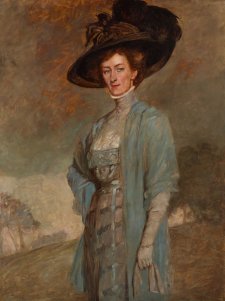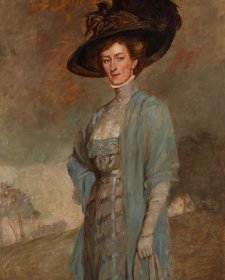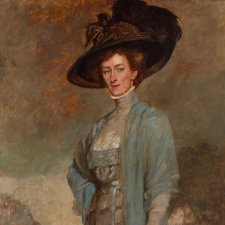- About us
- Support the Gallery
- Venue hire
- Publications
- Research library
- Organisation chart
- Employment
- Contact us
- Make a booking
- Onsite programs
- Online programs
- School visit information
- Learning resources
- Little Darlings
- Professional learning
South African-born Florence Fuller was a child when her family emigrated to Victoria. At 16 she enrolled at the National Gallery School in Melbourne, and she later studied with her uncle, the distinguished portraitist Robert Dowling. In 1891 she was described as ‘a young artist, who by her clever and conscientious work, has placed herself among the best Australian portrait painters’. In Europe from 1893, she studied at the Académie Julian in Paris and exhibited at the Salon, and at the Royal Academy and the Royal Institute of Oil Painters in London. After returning to Australia in 1904 she settled in Perth and established a studio in the building that housed the offices of the newspaper, the West Australian. Consequently, she came to the attention of Sir John Winthrop Hackett – the newspaper’s owner – who commissioned Fuller to paint at least two portraits of his wife Deborah Vernon Hackett (1887–1965). Later the Lady Mayoress of Adelaide, a mining company director and a charity fundraiser, Deborah was 18 when she married Hackett in August 1905. The tea gown in this portrait of her by Fuller matches descriptions of the one Lady Hackett changed into before setting off on her honeymoon.
Purchased with funds provided by Marilyn Darling AC 2005
This portrait of Deborah Vernon Hackett was made around 1908 by Florence Ada Fuller. It is painted with oil on canvas and measures 82 centimetres tall by 64 centimetres wide. The ornate gold frame is 13 centimetres wide. At the lower edge in the centre of the frame in black handwritten print is the inscription Mrs J.W. Hackett aet. 16. and beneath this F.A. Fuller.
The young woman is painted realistically with light brushstrokes and soft edges. She is positioned centrally, taking up the bottom two thirds of the canvas in front of a plain dark background. Deborah looks directly towards us. She is visible to her thigh which is seated in a cane chair.
The background is dark olive green. Vertical lines near the top of the painting suggest the folds of a curtain. This graduates to deep shadows that are almost black on the lower left.
Deborah wears a large black hat with a low flat crown. A few dashes of paint indicate a bow of gauzy ribbon peeping above the wide brim that sweeps upwards on either side of her head. Her medium-brown hair is drawn off her forehead and curves up and out, giving volume and framing her face. The rest of the hair hangs loose behind her, with a small section falling in gentle waves over her left shoulder.
Light touches Deborah’s face from the right of the painting, leaving the left side in partial shadow. Her oval face has a smooth fair complexion and cheeks tinged with delicate pink. Her brown eyebrows are fine and straight. Deborah’s sea-blue eyes look directly at us, their outer edges follow a slightly downwards lilt. Her nose is straight, leading to small shapely lips. The corners of her mouth are slightly upturned, the rose-pink lips are closed. Deborah has a faint groove just beneath her lower lip and a little round chin.
A band of cream open lacework encircles Deborah’s neck and extends over her chest. It is secured beneath her chin with a slender gold pin. A long strand of pale pink irregularly shaped stones also hangs about her neck. Her dress is light blue-green, and the fabric looks almost sheer, with a subtle silk-like sheen. Cream-coloured lace runs horizontally across the upper bodice, further ornamented in the middle of her chest by an oblong-shaped reddish gold pin. The sleeves are embellished with lace above the elbows and on the lower edges of the cuffs.
The cuffs of her wide sleeves hang elegantly from her wrists, creating strong almost-vertical lines in parallel with the arm of the straw-coloured cane chair. Deborah’s left hand, displaying the glint of a gold band on her ring finger, is lightly placed over her right on the top of the chair’s arm. Beneath her hands the rounded scroll-shaped edge of the chair is emphasized by its plaited edge.
The back of the cane chair curves down from the arm around her body following the sloping line of Deborah’s left hip at the lower right of the painting. On the bottom left the artist’s signature F. A. Fuller can be seen faintly in brownish pink over the dark background.
Audio description written by Lucinda Shawcross and voiced by Amy Middleby
Florence Ada Fuller (age 38 in 1905)
Lady Deborah Vernon Hackett (age 18 in 1905)
Marilyn Darling AC (33 portraits supported)



On one level The Companion talks about the most famous and frontline Australians, but on another it tells us about ourselves.



Jennifer Higgie uncovers the intriguing stories behind portraits of women by women in the National Portrait Gallery’s collection.



Spanning the 1880s to the 1930s, this collection display celebrates the innovations in art – and life – introduced by the generation of Australians who travelled to London and Paris for experience and inspiration in the decades either side of 1900.